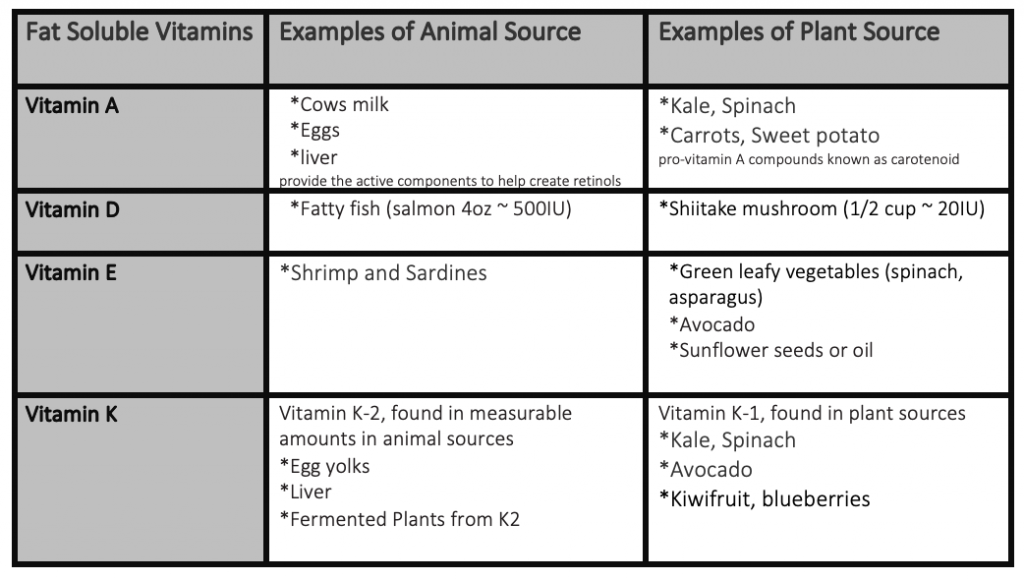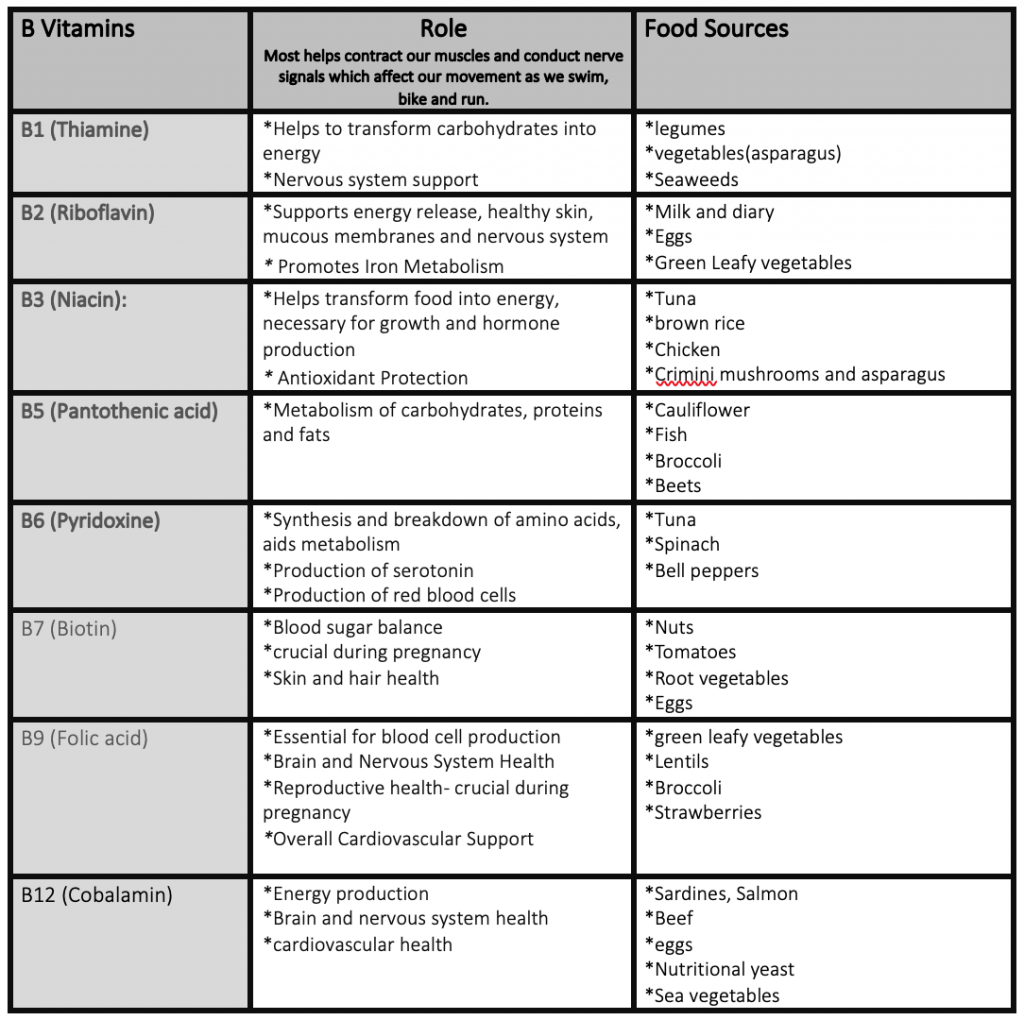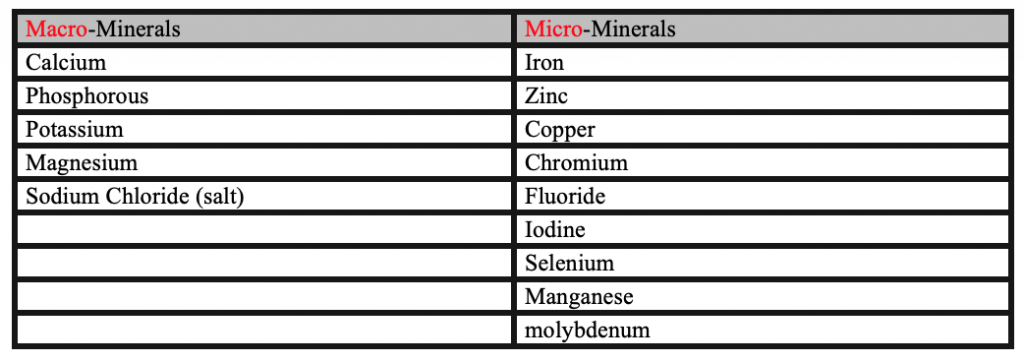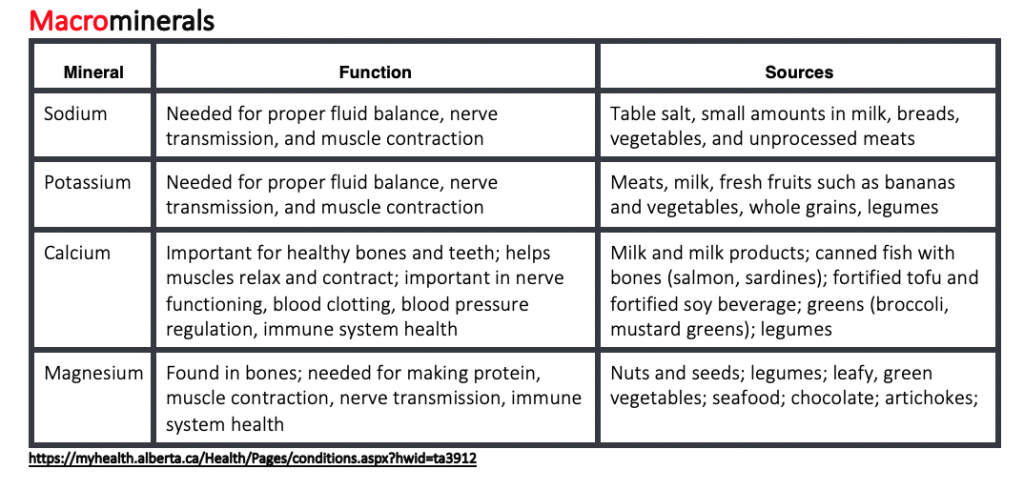Fuel for Thought
Weekly Column By Barb Bryan, BSc(Pharmacy), BSc(Nutrition) APA PRESCRIBING RIGHTS
Macronutrients – Part 6 in a 6-part series
Micronutrients – The little guys
Remember when your mom told you to eat your vegetables? Turns out she was right!
Over the last five weeks the three macronutrients (carbohydrates, protein and fat) have garnered a good amount of attention here and rightfully so, since they are the professional athletes of nutrition. However, for these three macros to become the stars they need a great support team behind the scenes to make sure the production runs smoothly. This is where the mighty little guys called ‘micronutrients’ come into play. Just because something is small doesn’t mean that its influence isn’t giant. If we want the full package of a healthy and happy body, we must think about the whole crew (Macro and Micro Nutrients) working as a team. There are “no weak LYNX” among this healthy squad. ?
Unlike macronutrients, micronutrients are only required in very small amounts. We need some of them in quantities of less than 100 milligrams per day. And if that sounds like a lot, it isn’t. One hundred milligrams is equivalent to 1/10thof a gram or the weight of roughly 1/10thof a pinch of salt.The Dietary Reference Intakes (DRIs) are nutrient reference values developed by the Institute of Medicine of The National Academies. They are intended to serve as a guide for good nutrition and provide the scientific basis for the development of food guidelines in both the United States and Canada- DRI’s.[1] DRIs are just the minimum amounts needed to prevent deficiencies and reduce risk of developmental abnormalities and chronic diseases.
We consider micronutrients essential for life since majority of these elements are not produced in the body and must be derived from the diet [2].The main purpose of these nutrients are to enable thousands of chemical reactions to occur in the body which are vital for:
- Energy creation
- Cognitive function
- Normal hemoglobin levels
- Hormone synthesis
- Cell function
- Repairing damaged tissue
- Immune strength
- Bone development
- Skin and hair health
Even though micronutrients do not directly provide energy (calories), these itty-bitty vitamins, minerals and phytochemicals have a BIG job to do and they pack a powerful punch for our overall health!
You might recall the story about the many British sailors who died with scurvy, but the cats on the ships survived, because they could synthesize their own vitamin C. The sailors began eating lemons and limes – containing vitamin C- to survive sea voyages. Thus the sailors earned the nickname “limey,” a word that is often still used colloquially for persons of British descent. These types of micronutrient deficiency diseases have been very common throughout human history. Generally in high-income, developed countries these days, extreme micronutrient deficiency is rare. A comprehensive representative analysis of U.S. populations finds that only 5 percent or more is affected by deficiencies in vitamins B6, C and D, and almost 10 percent of women of child-bearing age are affected by low body iron [4].
However, what is happening is slow long term micronutrient “insufficiencies” and there may be many reasons for this:
- Poor food choices – Eating less than optimal amounts of important micronutrients. The Canadian Community Health Survey, 2014, indicates that less than 50%of Canadian households ate the minimum recommended number of fruits and vegetables per day.[3]
- Socioeconomic status
- The mineral content of plant foods varies with the soil content
- Obesity
- Medication and Digestive issue that reduces absorption of nutrients (e.g.: medications that lower stomach acid, antibiotic use, inflamed bowel or celiac disease).
- Pregnancy (Micronutrient demands increase)
- Lifestyles that may require increased need for nutrients (e.g. athletes, smokers, heavy alcohol consumption).
- Combination of certain foods that can either increase or decrease bioavailability of nutrients (like vitamin C taken with iron or tannins in tea ingested with iron respectively)
These micronutrient insufficiencies, if left unchecked, can have harmful long term consequences that are, unfortunately, not always immediately evident. This can contribute to a number of major illnesses, such as heart disease, type 2 diabetes, cancer, anemia, low immunity and osteoporosis. So, from a health and athletic performance standpoint, we need to seriously double down on this advice: eating a colourful, well-balanced, diverse diet and potentially supplementing is critical to maintaining the proper levels of micronutrients in the body. Often our athletic nutrition talks stop at the macronutrient levels (e.g. carbs, protein and fats) and micronutrients get lost in the discussion. Micronutrients are the true building blocks of nutrition and are vital to an athlete’s performance. Without them our cells function at a fraction of their potential.
How do Vitamins and Minerals Differ?
Vitamins are organic and can be a bit more fragile when exposed to light, heat, air and acids. Minerals are inorganic and hold on to their chemical structure.
So why does this matter? It means the minerals in soil easily find their way into your body through the plants, fish, animals, and fluids we consume. But it’s a little bit harder to transport vitamins from food and other sources into your body because cooking, storage, and simple exposure to light and air can deactivate these more fragile compounds.
Vitamins
Molecules that the body cannot manufacture but needs for growth, maintenance and indirectly energy production. Two exceptions are Vitamin D, which can be produced internally from skin exposure to the sun and Vitamin K2, which can be produced by intestinal bacteria
Did you know?
Vitamins are classified as either fat-soluble or water-soluble
- Fat-soluble – These are vitamins that dissolve in fat and are stored in the fat tissue in our bodies. We do not excrete them. Fat-soluble vitamins “require” fat to be present in the small intestines for absorption into circulation to occur.
- Water-soluble– These are vitamins that dissolve in water and are not stored in the body. They are easily absorbed from the small intestine and do not require fat to be present. Once your body uses up all the water soluble vitamin it needs, the unused amount is then sent to your kidneys to get released from your body when you urinate.
- Fat-soluble (A, D, E, and K)– Four (4)
Vitamin A – Is important for immune system support, vision health and reproduction.
Vitamin D – The “sunshine vitamin” aids in the absorption of calcium for strong bones, aids in blood sugar control and is vital for immunity.
The prevalence of vitamin D inadequacy in athletes is prominent. The risk significantly increases in higher latitudes, in winter and early spring seasons, and for indoor sport activities. Regular supplementation is essential to ensure healthy athletes.[5]
Vitamin E – Antioxidants that works together with vitamin C to protect cells from environmental damage and keep cell membranes healthy.
Vitamin K – Named after the German word for blood clotting (koagulation) – helps the blood clot, so wounds can heal and also important in bone health.

A few important tips to remember about Vitamin A, D, E and K
To properly absorb these fat soluble vitamins in supplement form, it helps to consume them with a little dietary fat (e.g., Vitamin D drops are manufactured in a liquid EVOO base for this reason). Furthermore, eating healthy fats, like an avocado, or a whole egg will help you derive more fat-soluble vitamins, because the fats you are digesting contain the nutrients.
We should also be aware that ironically some of our best foods for obtaining fat soluble vitamins listed above—for example, sweet potatoes, carrots, and leafy greens—contain very little fat (less than 1 gram per serving) making absorption of the vital A, D, E or K vitamins from a carrot itself hard. The solution is mingling these lower fat foods rich in fat soluble vitamins with higher fat foods like nuts, hummus, oils, salmon or avocado at time of ingestion. This will increase the absorption of these fat soluble vitamins. (Think – green leafy salad with avocado and side dish of salmon, carrots with hummus or ¼ of an avocado)
Also, since fat-soluble vitamins can be stored in our bodies, we must be aware of the amount of Vit. A, D, E or K supplements we are ingesting. Although it’s difficult to overload, you could, for example, take in too much and potentially accumulate toxic levels of these vitamins. It’s always wise to check with your health care provider before starting supplements to make sure there are no contraindications with your personal health profile.
- Water-soluble vitamins (8 B vitamins and vitamin C) – Nine (9) in total
Eight – B vitamins = B1 (Thiamine), B2 (Riboflavin), B3 (Niacin), B5 (Pantothenic acid), B6 (Pyridoxine), B7 (Biotin), B9 (Folic acid), and B12(Cobalamin)
I bet you are asking – what about (B4, B8, B10, etc.)? The short answer is they were discovered and later turned out not to be vitamins at all. To avoid confusion, scientists now prefer to use the B vitamin names instead of the numbers.
B vitamins are real multitaskers and are involved in so many critical processes. We now understand that B vitamins are a group of vitamins often found in the same foods and frequently function together as a team.
- B-vitamins allow your body to extract energy from the macronutrients you eat
- They also help form red blood cells
- Reduce cancer risk
- Vital in creating neurotransmitters responsible for brain health and improved mood
- Improve immunity

Vitamin C– also called ascorbic acid – is pivotal for many reasons:
- Vitamin C must be present for the synthesis of collagen, which is why you would literally fall apart without it. It also helps maintain healthy tendons and ligaments.
- Cofactor in conversion of dopamine to norepinephrine and thus important for brain health
- Vitamin C is a powerful aqueous-based antioxidant. It travels through the body neutralizing any free radicals.
- Vital to the function of a strong immune system.
One of many interesting claims of vitamin C as an antioxidant is its ability to aid iron being absorbed in the intestine. Including vitamin C-rich foods in recipes with your best iron sources can potentially be a way to enhance iron absorption.
Our best food sources of vitamin C have a single thing in common: they are all plant foods.
*Citrus foods like oranges, grapefruit, lemons and limes
*Many non-citrus fruits are highly rated sources, as well. Examples include strawberries, pineapple, kiwifruit, cantaloupe, and raspberries.
*Green leafy vegetables
The water-soluble vitamins, (B complex team and C), do not have to be eaten with fat to be absorbed, and it’s harder to overdose on these vitamins, as the body can flush them out via the urine.
Minerals
Minerals are elements that originate in the earth and cannot be made by living organisms. Plants obtain minerals from the soil, and most of the minerals in our diets come directly from plants or indirectly from animal sources that ingested the plants. The body does not manufacture minerals, but they are found in a variety of foods – fruit, vegetables, dairy, meat, nuts. Not all foods have the same types and amounts of minerals; and too little or too much of any mineral is not healthy. They are further classified into:
- Macrominerals: minerals that your body requires in larger amounts.
- Microminerals: minerals that your body requires in trace amounts.

Just like vitamins, minerals help your body grow, develop, and stay healthy. We use minerals to perform many different functions:
- Build strong bones
- Transmit nerve impulses and muscular contractions
- Produce hemoglobin to carry oxygen
- Make hormones or maintain a normal heartbeat
- Healthy immune function
- Improve cognitive function
- Fluid balance
- Energy production
Many of the macrominerals above (sodium, chloride and potassium) are often referred to as electrolytes and play a key role in hydration. Sticking with the macrominerals, we also know that magnesium, in terms of exercise and performance, are involved in proper muscle function. During strenuous bouts of activity we lose these macrominerals in our sweat and require supplementation. It is imperative that we maintain a micronutrient dense diet to keep the optimal levels of each vitamin and mineral in order to function at our healthiest and perform at our best.


Phytochemicals
What are phytochemicals?
Phytochemicals are chemicals produced by plants. These are the chemicals that plants use to defend themselves against disease. Examples include beta-carotene (in carrots), lycopene (in tomatoes), or resveratrol (in grapes). Research has shown that these same chemicals can prove equally beneficial to the human body, helping in areas like cancer, heart disease and diabetes prevention.
They are typically found in the same foods that essential micronutrients (vitamins and minerals) are in, therefore adding an array of plant-based foods into your diet is the simplest and easiest way to increase the amount of these “extra” micronutrients in your body.
It’s important to remember that no single food has every vitamin and mineral your body needs. So a well-balanced and diverse diet is critical to maintaining the proper levels of micronutrients in the body. Eat the Rainbow?
- https://nationalacademies.org/hmd/~/media/Files/Activity%20Files/Nutrition/DRI-Tables/7_%20Nutrients%20Summary.pdf?la=en
- Sight & Life: Micronutrients; Macro Impact, the Story of Vitamins and a Hungry World, 2011
- https://www.statcan.gc.ca/pub/82-625-x/2015001/article/14182-eng.htm
- https://www.cdc.gov/nutritionreport/pdf/Nutrition_Book_complete508_final.pdf
- https://www.ncbi.nlm.nih.gov/pubmed/25277808
